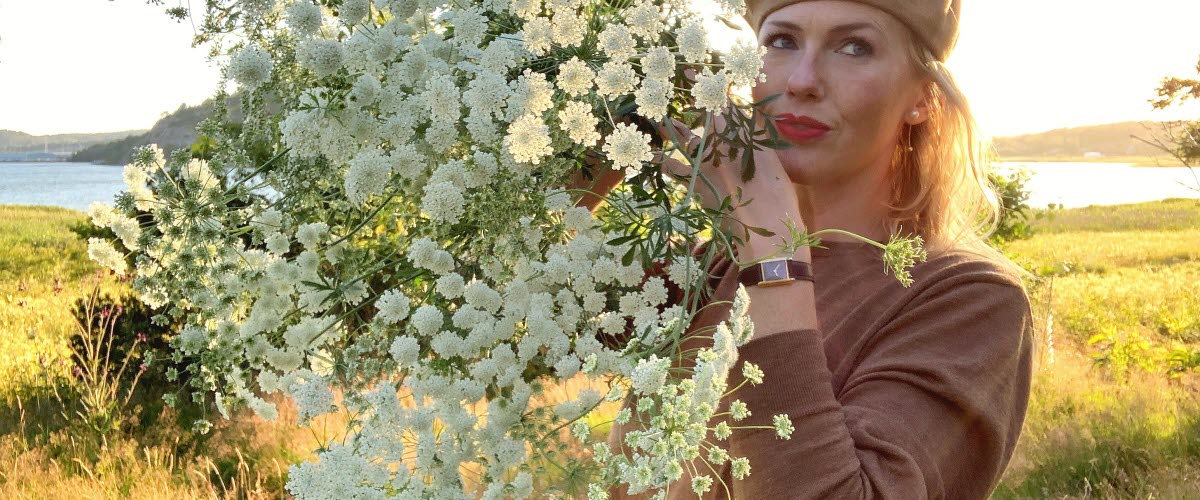For Emily, a garden means creativity and joy
Emily Bratt is a gardener who has created her own green plant kingdom on Tjörn in Bohuslän. What does Emily say about West Sweden's burgeoning garden tourism and which gardens would she recommend visiting?
Castle Garden and Flower appeal
Emily Bratt is the gardener who runs En annan slags trädgård (A Different Kind of Garden) by Svanvik beach on the island of Tjörn. She has received a lot of media attention recently as one of the initiators behind Blomsteruppropet (“Flower appeal”) and has become a keen advocate for the Slow flower movement. How do these two gardeners view the growing garden tourism in West Sweden?
How would you define a garden?
- In basic terms it is a green area with boundaries containing cultivated plant material, but gardens are also the obvious extension of a house. For me, a garden is something real, something important and authentic, associated with many different feelings. There are smells connected with childhood memories. Living in the present and in the season. Being made to wait and long for things. A garden is also a source of creativity and the joy of creating.
Photographer: Jonatan Fernström
Landscape diversity
What defines a typical garden in West Sweden ? There is no simple answer to this question, because even though the landscapes here have clear characteristics, they also have a rich diversity of species and include almost all of Sweden's plant zones. Garden enthusiasts often talk about the Coastline & Cottage Gardens in Bohuslän, Woodland in Dalsland and Meadow in Västergötland. The essence of gardens in West Sweden are their summer meadow flowers, honeysuckle, roses, lilac arbours and tough perennials. There are fragrant heathers and junipers, birch, old fruit trees, berry bushes and round-pole fences. The granite and water of Bohuslän are natural features in many gardens as well.
What are the special qualities of our gardens in West Sweden?
- Wow, there are so many variations in plants and so many different landscape images that belong to West Sweden. It feels natural for me to highlight the character of the landscape around me and is what I wake up to every morning. This means lush meadows with reeds and meadowsweet, mixed forest, stone walls, the sea, junipers and lots of honeysuckle!
Photographer: Jonatan Fernström
What are the most important elements in your creative process?
- It is important for me to create diversity in a garden - I want to have many different types of plant communities. This gives a wide diversity among both flora and fauna. Animals and gardens belong together. Animals give life to a garden and create a whole. The best results are always when your starting point is the biotope. This means that you should start with the natural conditions at the site. I really like to take the wild flora from surrounding landscape into the garden, though in a refined form.
What sort of tips about green experiences would you like to give to people visiting West Sweden?
- West Sweden is so large that I would recommend dividing it into two garden tours. One would cover Bohuslän, including Sundsby Säteri as obvious place. For a longer tour I would include the Gothenburg area, with all the parks and gardens it has to offer. Enjoy the green diversity of our open gardens and enjoy some coffee and cakes or an organic lunch among the roses and fruit trees. Browse among the range of local produce and arts and crafts in the farm shops and you’ll find enough green power to last all year round. Remember the effects of the season! Some areas are at their best at specific times of the year.
Photographer: Maria Johannessen
The green treasure map
The association called Trädgårdsresan (Garden Journey) has created an interactive treasure map of gardens that are open to the public in West Sweden. The name of the website is Trädgårdsresan (Garden Journey) and it describes gardens you can visit at castles, manor houses and farms, in garden landscapes and cultural environments. The list also includes a number of smaller private gardens.


